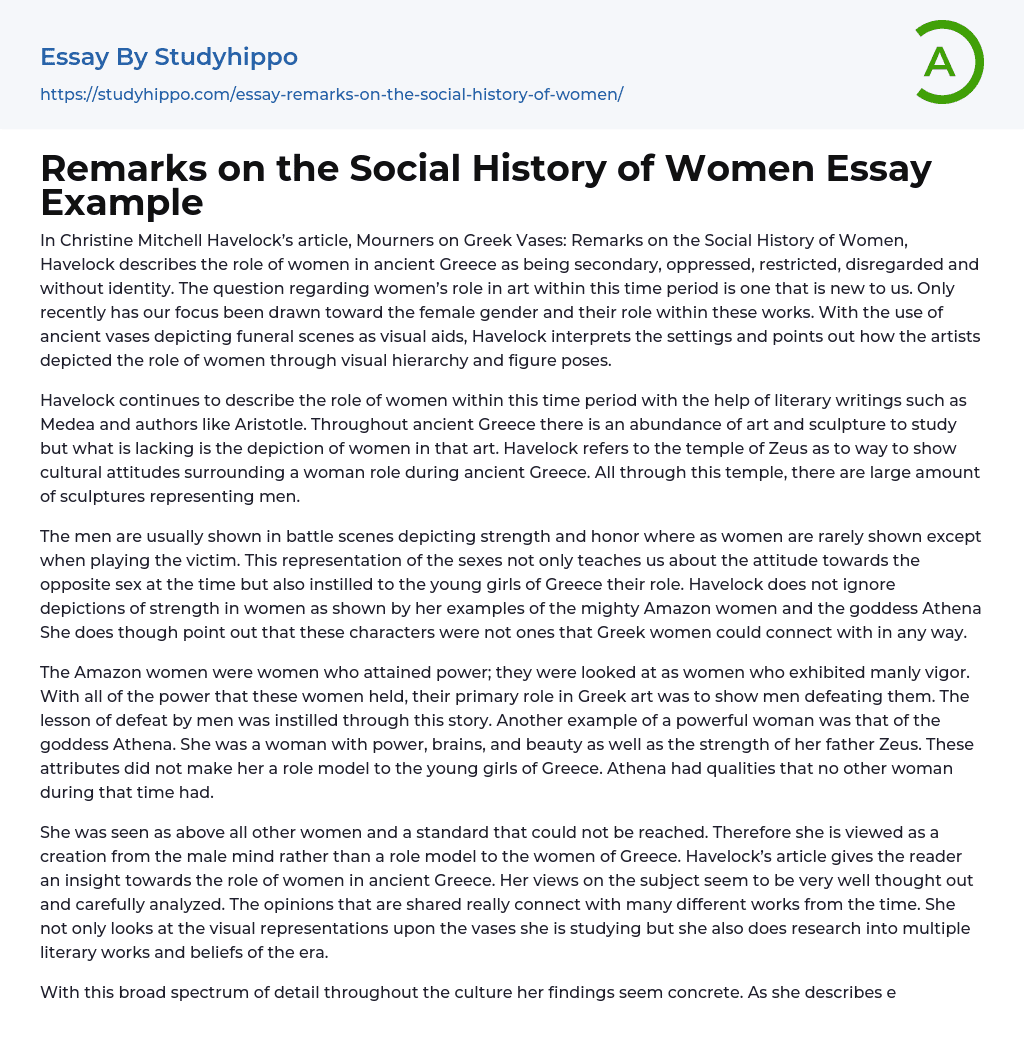In Christine Mitchell Havelock’s article, Mourners on Greek Vases: Remarks on the Social History of Women, Havelock describes the role of women in ancient Greece as being secondary, oppressed, restricted, disregarded and without identity. The question regarding women’s role in art within this time period is one that is new to us. Only recently has our focus been drawn toward the female gender and their role within these works. With the use of ancient vases depicting funeral scenes as visual aids, Havelock interprets the settings and points out how the artists depicted the role of women through visual hierarchy and figure poses.
Havelock continues to describe the role of women within this time period with the help of literary writings such as Medea and authors like Aristotle. Throug
...hout ancient Greece there is an abundance of art and sculpture to study but what is lacking is the depiction of women in that art. Havelock refers to the temple of Zeus as to way to show cultural attitudes surrounding a woman role during ancient Greece. All through this temple, there are large amount of sculptures representing men.
The men are usually shown in battle scenes depicting strength and honor where as women are rarely shown except when playing the victim. This representation of the sexes not only teaches us about the attitude towards the opposite sex at the time but also instilled to the young girls of Greece their role. Havelock does not ignore depictions of strength in women as shown by her examples of the mighty Amazon women and the goddess Athena She does though point out that these characters were not
ones that Greek women could connect with in any way.
The Amazon women were women who attained power; they were looked at as women who exhibited manly vigor. With all of the power that these women held, their primary role in Greek art was to show men defeating them. The lesson of defeat by men was instilled through this story. Another example of a powerful woman was that of the goddess Athena. She was a woman with power, brains, and beauty as well as the strength of her father Zeus. These attributes did not make her a role model to the young girls of Greece. Athena had qualities that no other woman during that time had.
She was seen as above all other women and a standard that could not be reached. Therefore she is viewed as a creation from the male mind rather than a role model to the women of Greece. Havelock’s article gives the reader an insight towards the role of women in ancient Greece. Her views on the subject seem to be very well thought out and carefully analyzed. The opinions that are shared really connect with many different works from the time. She not only looks at the visual representations upon the vases she is studying but she also does research into multiple literary works and beliefs of the era.
With this broad spectrum of detail throughout the culture her findings seem concrete. As she describes each of her views on her topic, it becomes evident to the reader that she has an extensive background in art history and expects that the reader also have a similar
knowledge of the subject matter. With this understanding her points come from an educated analysis rather than pure opinion. All readers must have a basic level of knowledge in art history since her ideas are a more in depth look toward the work.
With works of art being so subjective, especially older works that come from a time where society and culture are so different from our own, each person will always interpret details differently. Although Havelock’s ideas are well thought out and backed up with different examples, there is always a sense of doubt as to whether we are taking some insignificant detail and molding it into a meaning that it was not intended for. In the end the reader will make his or her own decisions as to whether the article is convincing or not.
- Creativity essays
- Art History essays
- Theatre essays
- Pastoral essays
- Visual Arts essays
- Postmodernism essays
- Symbolism essays
- ballet essays
- Color essays
- Modernism essays
- Mona Lisa essays
- Work of art essays
- Body Art essays
- Artist essays
- Cultural Anthropology essays
- Ethnography essays
- Aesthetics essays
- Realism essays
- Heritage essays
- Harlem Renaissance essays
- Concert Review essays
- Voice essays
- Theatre Of The Absurd essays
- Playwright essays
- Scotland essays
- Tennessee williams essays
- Design essays
- Graffiti essays
- Graphic essays
- Typography essays
- Painting essays
- Photography essays
- Sculpture essays
- Architecture essays
- Interior design essays
- Arch essays
- Area essays
- Tattoo essays
- Pablo Picasso essays
- Vincent Van Gogh essays
- Michelangelo essays
- Frida Kahlo essays
- Woman essays
- Boy essays
- Homosexuality essays
- Masculinity essays
- Sexual Orientation essays
- Girl essays
- Man essays
- Lgbt essays




